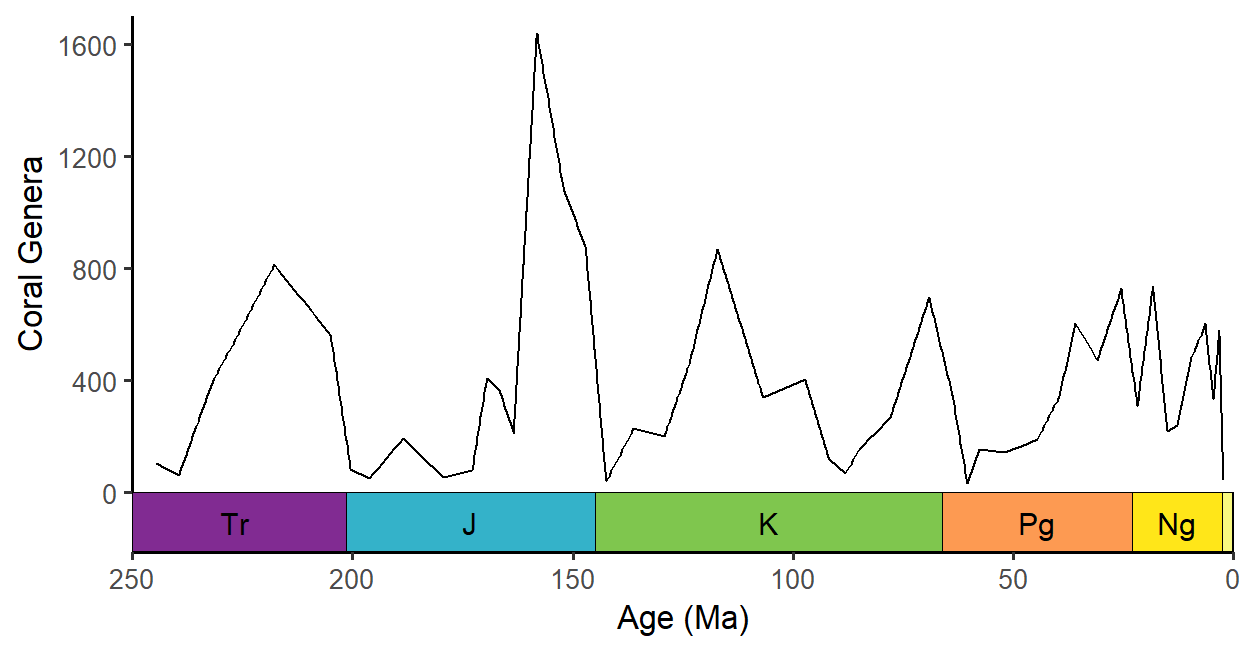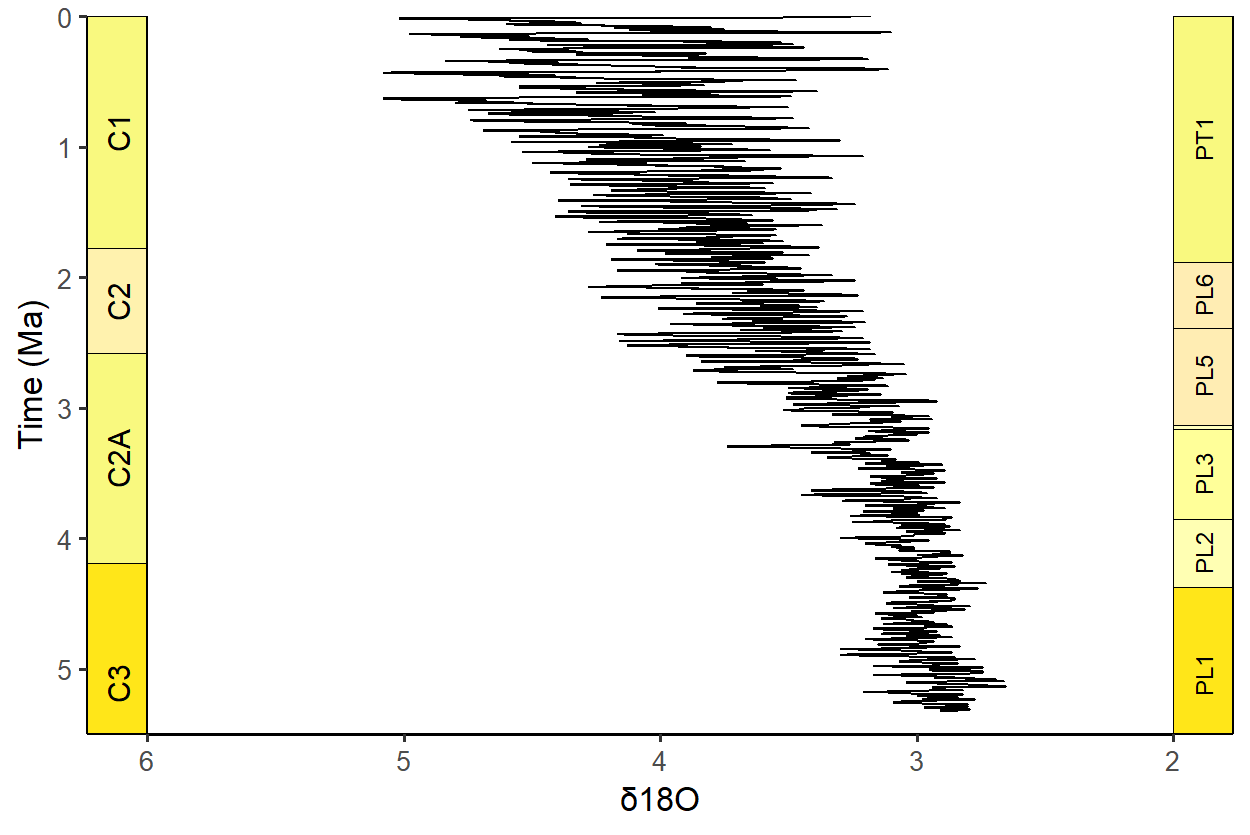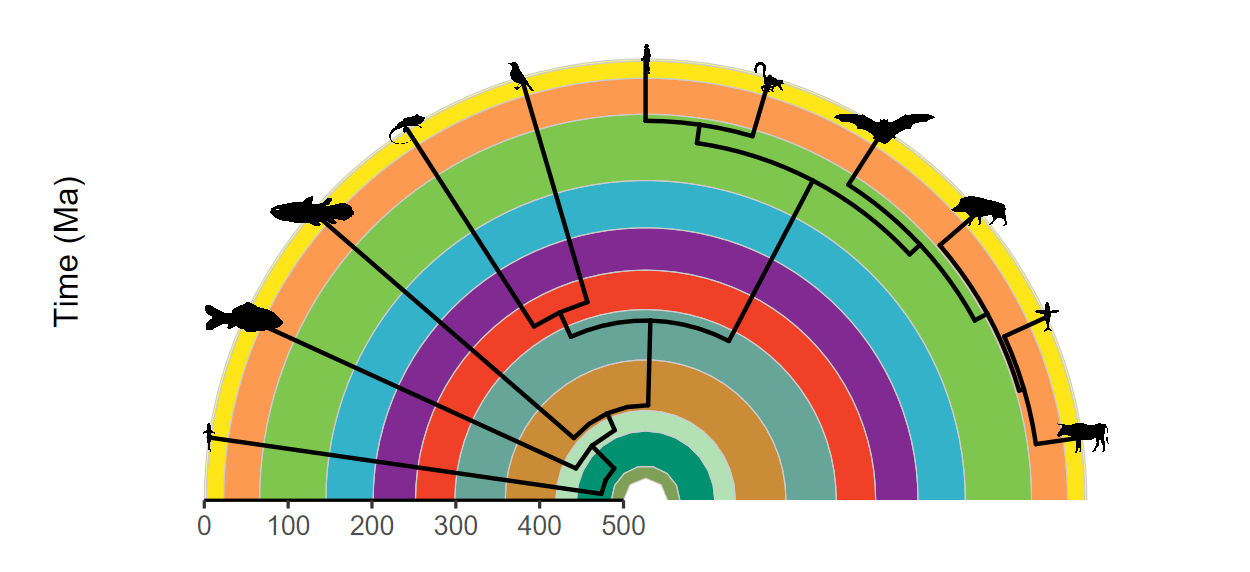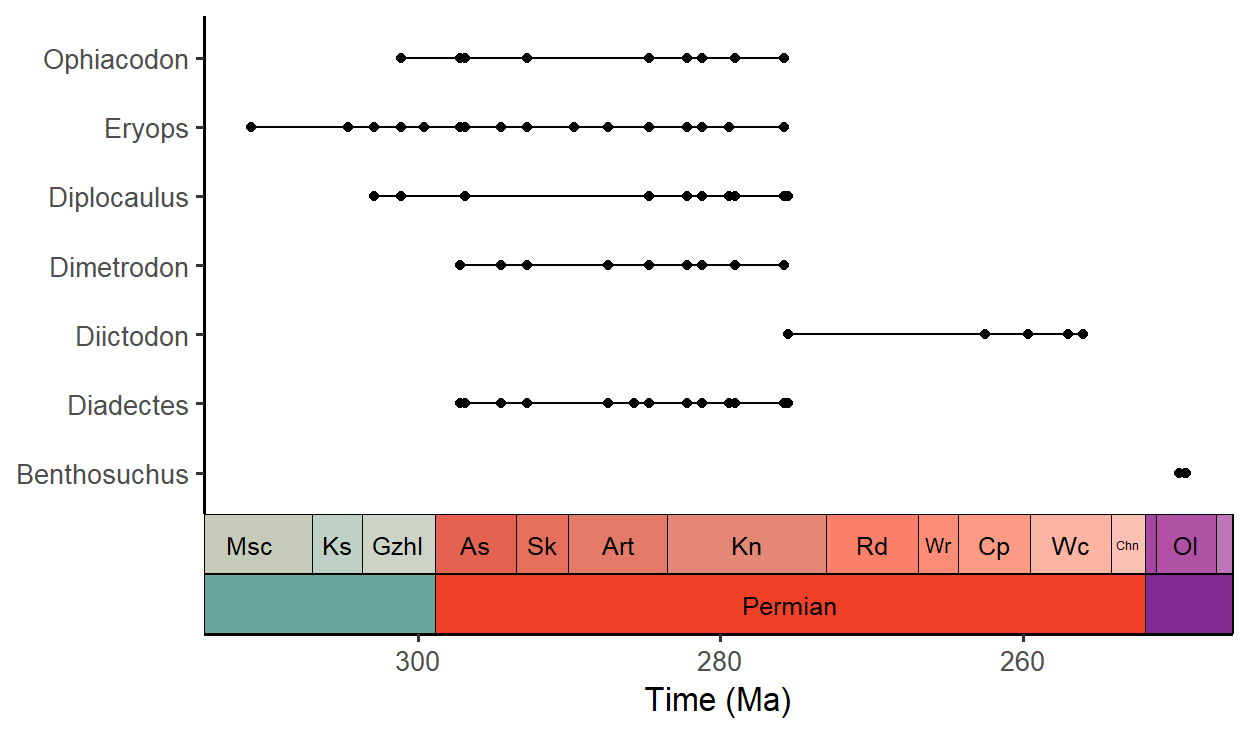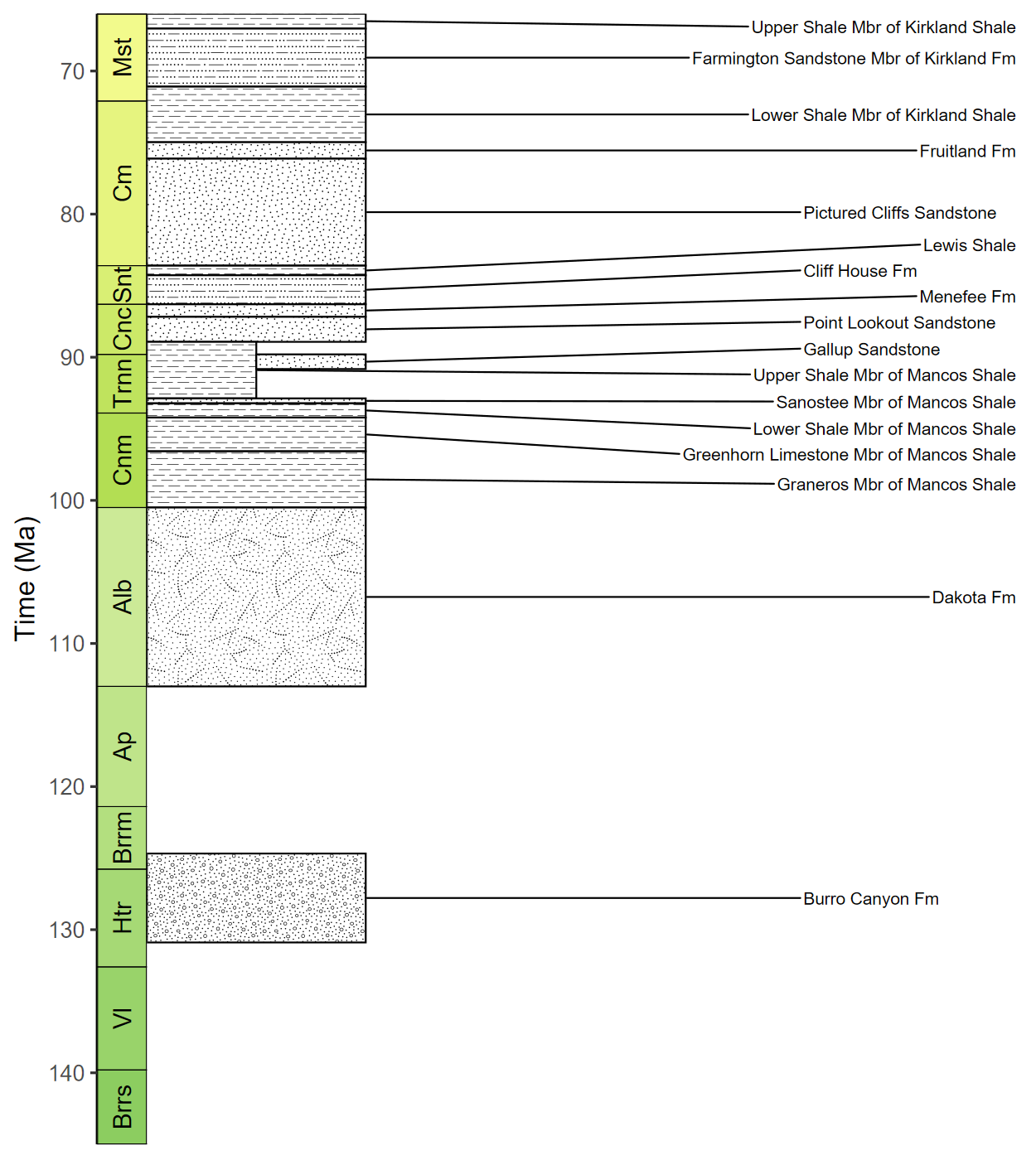deeptime extends the functionality of other plotting packages (notably
{ggplot2}) to help facilitate the plotting of data over long time intervals,
including, but not limited to, geological, evolutionary, and ecological data.
The primary goal of deeptime is to enable users to add highly customizable
timescales to their visualizations. Other functions are also included to assist
with other areas of deep time visualization.
# get the stable version from CRAN
install.packages("deeptime")
# or get the development version from github
# install.packages("devtools")
devtools::install_github("willgearty/deeptime")library(deeptime)
library(ggplot2)
library(dplyr)The main function of deeptime is coord_geo(), which functions just like coord_trans() from {ggplot2}.
You can use this function to add highly customizable timescales to a wide variety of ggplots.
library(divDyn)
data(corals)
# this is not a proper diversity curve but it gets the point across
coral_div <- corals %>% filter(stage != "") %>%
group_by(stage) %>%
summarise(n = n()) %>%
mutate(stage_age = (stages$max_age[match(stage, stages$name)] +
stages$min_age[match(stage, stages$name)])/2)
ggplot(coral_div) +
geom_line(aes(x = stage_age, y = n)) +
scale_x_reverse("Age (Ma)") +
ylab("Coral Genera") +
coord_geo(xlim = c(250, 0), ylim = c(0, 1700)) +
theme_classic(base_size = 16)# Load packages
library(gsloid)
# Plot two different timescales
ggplot(lisiecki2005) +
geom_line(aes(x = d18O, y = Time / 1000), orientation = "y") +
scale_y_reverse("Time (Ma)") +
scale_x_reverse("\u03B418O") +
coord_geo(
dat = list("Geomagnetic Polarity Chron",
"Planktic foraminiferal Primary Biozones"),
xlim = c(6, 2), ylim = c(5.5, 0), pos = list("l", "r"),
rot = 90, skip = "PL4", size = list(5, 4)
) +
theme_classic(base_size = 16)# Load packages
library(ggtree)
library(rphylopic)
# Get vertebrate phylogeny
library(phytools)
data(vertebrate.tree)
vertebrate.tree$tip.label[vertebrate.tree$tip.label ==
"Myotis_lucifugus"] <- "Vespertilioninae"
vertebrate_data <- data.frame(species = vertebrate.tree$tip.label,
name = vertebrate.tree$tip.label)
# Plot the phylogeny with a timescale
revts(ggtree(vertebrate.tree, size = 1)) %<+%
vertebrate_data +
geom_phylopic(aes(name = name), size = 25) +
scale_x_continuous("Time (Ma)", breaks = seq(-500, 0, 100),
labels = seq(500, 0, -100), limits = c(-500, 0),
expand = expansion(mult = 0)) +
scale_y_continuous(guide = NULL) +
coord_geo_radial(dat = "periods", end = 0.5 * pi) +
theme_classic(base_size = 16)library(palaeoverse)
# Filter occurrences
occdf <- subset(tetrapods, accepted_rank == "genus")
occdf <- subset(occdf, accepted_name %in%
c("Eryops", "Dimetrodon", "Diadectes", "Diictodon",
"Ophiacodon", "Diplocaulus", "Benthosuchus"))
# Plot occurrences
ggplot(data = occdf) +
geom_points_range(aes(x = (max_ma + min_ma)/2, y = accepted_name)) +
scale_x_reverse(name = "Time (Ma)") +
ylab(NULL) +
coord_geo(pos = list("bottom", "bottom"), dat = list("stages", "periods"),
abbrv = list(TRUE, FALSE), expand = TRUE, size = "auto") +
theme_classic(base_size = 16)# Load packages
library(rmacrostrat)
library(ggrepel)
# Retrieve the Macrostrat units in the San Juan Basin column
san_juan_units <- get_units(column_id = 489, interval_name = "Cretaceous")
# Specify x_min and x_max in dataframe
san_juan_units$x_min <- 0
san_juan_units$x_max <- 1
# Tweak values for overlapping units
san_juan_units$x_max[10] <- 0.5
san_juan_units$x_min[11] <- 0.5
# Add midpoint age for plotting
san_juan_units$m_age <- (san_juan_units$b_age + san_juan_units$t_age) / 2
# Get lithology definitions
liths <- def_lithologies()
# Get the primary lithology for each unit
san_juan_units$lith_prim <- sapply(san_juan_units$lith, function(df) {
df$name[which.max(df$prop)]
})
# Get the pattern codes for those lithologies
san_juan_units$pattern <- factor(liths$fill[match(san_juan_units$lith_prim, liths$name)])
# Plot with pattern fills
ggplot(san_juan_units, aes(ymin = b_age, ymax = t_age,
xmin = x_min, xmax = x_max)) +
# Plot units, patterned by rock type
geom_rect(aes(fill = pattern), color = "black") +
scale_fill_geopattern() +
# Add text labels
geom_text_repel(aes(x = x_max, y = m_age, label = unit_name),
size = 3.5, hjust = 0, force = 2,
min.segment.length = 0, direction = "y",
nudge_x = rep_len(x = c(2, 3), length.out = 17)) +
# Reverse direction of y-axis
scale_y_reverse(limits = c(145, 66), n.breaks = 10, name = "Time (Ma)") +
# Theming
theme_classic(base_size = 16) +
theme(legend.position = "none",
axis.line.x = element_blank(),
axis.title.x = element_blank(),
axis.text.x = element_blank(),
axis.ticks.x = element_blank()) +
# Add geological time scale
coord_geo(pos = "left", dat = list("stages"), rot = 90)
